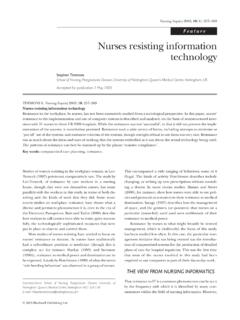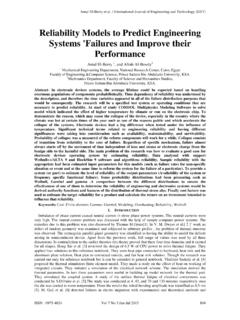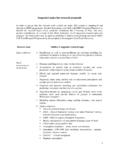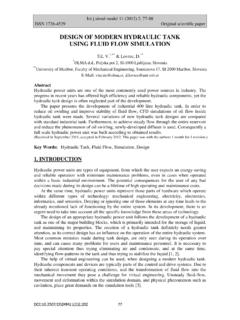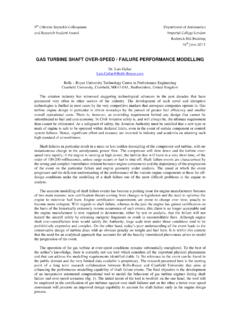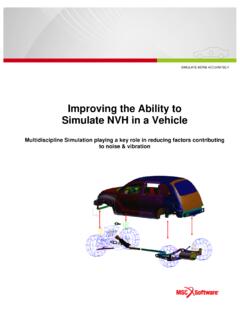Transcription of Health Informatics Journal - Interruptions
1 Organizational communication and awareness:a novel solution for Health informaticsAnne Adams, Ann Blandford, Dawn Budd and Neil BaileyAs organizations grow larger and more distributed, the problems of maintainingcorporate awareness and effective communication channels escalate. The clinicaldomain poses particular challenges to maintaining good corporate communi-cations because users have limited time to access information and often havenegative technology perceptions. This article highlights how a screen saver appli-cation, initially designed to increase privacy and security, developed into a newcommunication medium improving corporate communication across the organiz-ation. An ethnographic study of the application within a hospital setting,analysed using grounded theory methods, details the iterative and organicdevelopment of the design through community of practice involvement. Thisapplication and the evolutionary process through which it was developed werefound to not only increase awareness of resources, activities and hospital changesbut also positively influence users perceptions of, involvement in and ownershipof general IT developments.
2 User involvement also raised the importance, for thedesigners, of application usability, quality and , communities of practice, organizational awareness, social issuesIntroductionAs an organization grows and spreads to separate geographic locations, it becomes hardfor staff to retain an awareness of community activities, events and resources across thatorganization. Without organizational awareness, activities are likely to be duplicated orgo unnoticed by those who would appreciate them. Joint resources can be left unused,163 ArticleCopyright 2005 SAGE Publications (London, Thousand Oaks, CA and New Delhi)Vol 11(3): 163 178 [1460-4582(200509)11:3;163 178; DOI: ] Informatics Journalreducing the likelihood of a collective outlook. Users therefore need support in obtaininga shared understanding of corporate perspectives and establishing productive collabora-tions across an organization. This is especially true within the clinical domain where thecomplex, autonomous and hierarchical nature of the medical discipline can isolate usersfrom organizational issues [1].
3 A range of communication and awareness tools has been used to counteract thegrowing isolation of users and groups: the telephone, e-mail, video conferencing, sharedworkspaces, chatrooms and public information boards. Awareness technologies allowdistributed workers to be aware of their co-workers activities and of their potential forcollaboration. The applications range from video/audio links and sensors that locate anddetect workers current activities to a range of tools that increase awareness of collabora-tive activities such as meetings, seminars, shared tasks, etc. However, these tools cansimply lead to information overload and overlooked resources, as users lack the time orability to scan for relevant information or to set up mechanisms ( intelligent agents)to search for awareness interfaces provide awareness without interrupting the primarytask or requiring a secondary task ( initiating awareness tool) to occur.
4 These appli-cations have been of increasing importance in the literature but, as Cadiz et al. [2] note,there are few success stories where they have been used outside the lab situation. Oneof the main problems, which applications have sought to overcome, is how to increaseusers timely organizational awareness while avoiding needless distractions [3, 4]. Manyof these applications deal with the important issues of screen real estate, informationsearching and information question that needs to be asked is: should we be looking at information presen-tation and retrieval orthe role of information in users work? Wenger [5] argues thatlearning, within any domain, is more than the formal acquisition of knowledge or infor-mation: it has a social element and should be a process of participation in communitiesof practice. Recent information seeking research has highlighted the importance ofcomplex interactions between information, technology, work patterns and social contexts[6 8].
5 Very little research has been done on awareness applications adjusting to theworking patterns of the user. Providing information when a user s goal is notto findfurther information but to not work and break away from their current task is theprimary requirement addressed by the systems described discuss the iterative design process, which produced the screen saver and trafficlights applications, and the role of user involvement and communities of practice in the following section we review relevant awareness research, the context of theclinical domain and the importance of a community of practice approach. Next, wepresent the organizational context and the iterative design process adopted. This isfollowed by an ethnographic evaluation of each application, highlighting strengths andlimitations. Finally, the implications for further research and development are and community awareness of activities, resources and perspectives arehard to maintain in any organization.
6 Contextual factors can, however, have a stronginfluence on users awareness and use of technology. Social and economic backgrounds, Health Informatics Journal 11 (3)164for example, can impact upon technology expectations and usage patterns [9]. It is, there-fore, important to understand the effects that contexts and work practices and patternshave on our awareness and use of information and technology. The relationship betweentechnology, specifically a screen saver awareness application, communities of practiceand work patterns within the clinical domain are the focus of this applicationsResearch on awareness and related applications ( active badges, mobile and wearabledevices) has considered various kinds of awareness, but has mainly focused on workspaceand groupware awareness; for this, video images have been the main data source. Initially,awareness technologies aimed to allow distributed workers to maintain awareness of theirco-workers and of their potential for collaboration [10 14].
7 This field has developed intoa far wider variety of applications, awareness definitions and data sources. However, littlework has focused on organizational awareness of the kind considered recent years new approaches to awareness technologies have developed, includ-ing awareness notification systems and peripheral awareness interfaces. These systemsseek to develop more peripheral information delivery mechanisms, whereby communityawareness can be enhanced. Data sources are far more varied in these applications ( sites, community calendars), but the information content is often time-sensitiveand, to some degree, transient. Cadiz et al. [2] make the distinction between peripheralawareness applications on primary displays (users primary screens), secondary displays(extra or specialized monitors), ambient displays (embedded in users surrounding environ-ment) and mobile devices. Mobile devices, secondary and ambient displays representoften imaginative uses of technology; however, these often have limited impact withinorganizations because the initial outlay for the technology is such as Tickertape [15], Elvin [16], What s Happening [3] and Sideshow[2] remain on the users primary displays and seek to address the tensions between screenreal estate, user distraction and information depth.
8 Other peripheral awareness appli-cations on users primary displays either blend into the background of current screenimages [17] or remain on desktops, hidden by other applications but accessible whenrequired. All these applications require the user to deliberately access the awareness infor-mation. The user is required to initiate a change in their working pattern from interactionwith their current task to an awareness accessing task. Sideshow [2] provides a user-tailored interrupt application: an alert mechanism can be set up so that a box appearsnext to the sidebar with information about the alert ( when new e-mail has arrived).Applications that allow personalization are a useful tool. However, users that do not usethese tools may still require awareness information but do not wish, or are unable, tospend time setting up and accessing these resources. Ultimately, it is important to under-stand awareness application usage within the context of users work domain and communities of practiceAs already mentioned, it is important to identify the work patterns and practices ofcommunities within the organization.
9 A community s culture has a direct impact oncommunity practices that can develop into social norms [18]. Lave and Wenger [19]suggest that learning within any domain is more than a formal acquisition of knowledgeAdams et communication165or information: it has a social element, which is often ignored. They suggest that learningshould be a process of participation in communities of practice. This participation is atfirst peripheral, but gradually increases in both engagement and complexity. They arguethat the emphasis within learning should be on the whole person and is made up of theagent, activity and world. Wenger [5] extends this idea with a framework in which thetwo basic streams are practice (from collective social norms of practice to accounts ofmeanings) and identity(from impacts of organizational power and social structures tothose of personal subjectivity).
10 For awareness systems that support collaboration andinformation resources within communities of practice, understanding those communitieswould be communities within a corporate structure, although vital to team cohesion andcollaborative developments, can isolate groups from the organizational culture and norms[20]. Some domains encourage more discrete communities than others, segregating usersthrough the language, work practices and communication channels used. The clinicaldomain has a long history of isolated communities through its social structures and variedprofessions. Isolated communities, made up of many different professions with their ownspecific social identifiers, can often produce conflicts between those professions withinthe diverse organizational culture of the hospital [21 23]. Symon et al. [24] identifyconflicts within a clinical setting relating to social status and information procedures:higher-status professionals were found to be more concerned with keeping their statusas an expert than adhering to formal organizational norms.

